We are offering a few new plants this year and one is the Water Willow (Justicia Americana). This hardy bog plant has flowers that resemble an orchid white with splashes of lavender and purple. The flowers grow in a dense, head-like cluster originating from its slender stalks.
The plant will grow 12 inches to 18 inches high and about 12 inches wide with flowers that start blooming in April and will continue to bloom thru October. It requires part shade to full sun and best when planted 0 - 4" below the water surface but will take up to 2' of water. While it will grow in almost any type of soil its best grown in sandy, sandy loam medium loam and clay loam or clay.
Hardy Zones 4-11 (Can overwinter in pond and doesn't need submerged)
Well the holidays are over, the tree is down and all the holiday christmas decorations are put away. I could probably leave my christmas tree up for months as I always miss it once its put away. Its hard to imagine the room is exactly like it was a month ago because it looks so bare now. With that behind I start thinking that in just a few months it will be spring again. My how time flies. The plants are all beginning to grow nicely in the greenhouses and within a couple months will be ready to plant.
No sooner said then the snow began...let's hope February is a quick month and we can all get started on our spring projects and planning our gardens. Actually January is a good month to start ordering some plants for your gardens, at least I'm getting alot of plant magazines in the mail. So its getting me in the mood.
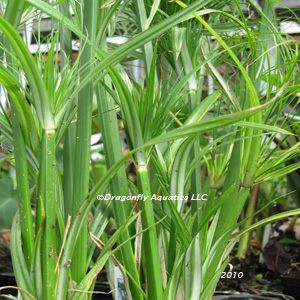 One of our most popular bog plants is the Dwarf Papyrus. I think its an unusual looking plant and adds alot of dimension to the pond. It always seems to grow well and is one pond plant that is easy to grow and attend to. The Dwarf Papyrus is a good bog plant to create a tub garden or tabletop pond. I have one growing in a ceramic pot on my patio and it does well.
One of our most popular bog plants is the Dwarf Papyrus. I think its an unusual looking plant and adds alot of dimension to the pond. It always seems to grow well and is one pond plant that is easy to grow and attend to. The Dwarf Papyrus is a good bog plant to create a tub garden or tabletop pond. I have one growing in a ceramic pot on my patio and it does well.
The papyrus grows in sun to part shade and likes moist soil and can tolerate water up to 4 inches deep. Its considered hardy Zones 8-11 but can easily be wintered over indoors. As long as you keep the plant in 50 degrees and above it will be fine. You may watch for mealybugs as they will sometimes appear on the plant during the winter but can easily be treated.
They grow 12-18 inches high with a spread of 6-12 inches. To start other plants take the seeds and put in wet soil or propagate from the viviparous top fronds. You'll soon have other plants to place in your pond.
If you like larger plants you can go for the Dwarf Giant Papyrus (Cyperus percamenthus) which will grow about 3 feet high. There is also the Egyptian Papyrus (Cyperus papyrus) which can grow to 8 feet high.
Whichever Papyrus you chose it is a unique pond plant for your pond.
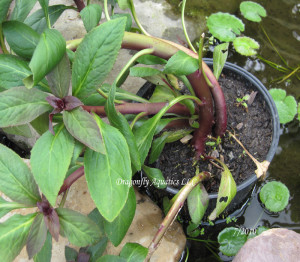 This is the Cardinal Flower I brought home from the greenhouse this spring and wondered at the time if it would straighten up. The Cardinal Flowers were all nice plants this year but some were growing slanted in their containers. The one I had planted a couple years ago didn't survive. Now I know we say "Don't Drown those bog plants" so I should know better. But too much water did it in, so I tried another. This year I'm glad to report it bloomed and flourished. It didn't straighten up until it started to bloom. I transplanted it after several weeks from its pot directly into my bog area and hoped that it wasn't too late to prevent it from blooming. I had wanted to give it some time to adjust to the water depth before I planted it directly in the pond but then I just got too busy to plant it. Look how gorgeous the flowers are. I think its a winner!
This is the Cardinal Flower I brought home from the greenhouse this spring and wondered at the time if it would straighten up. The Cardinal Flowers were all nice plants this year but some were growing slanted in their containers. The one I had planted a couple years ago didn't survive. Now I know we say "Don't Drown those bog plants" so I should know better. But too much water did it in, so I tried another. This year I'm glad to report it bloomed and flourished. It didn't straighten up until it started to bloom. I transplanted it after several weeks from its pot directly into my bog area and hoped that it wasn't too late to prevent it from blooming. I had wanted to give it some time to adjust to the water depth before I planted it directly in the pond but then I just got too busy to plant it. Look how gorgeous the flowers are. I think its a winner!
Not only did it get one flower but I have several more getting ready to bloom. Now that its established it will spread to even a healthlier plant by next year. At least that's my hope.
 This versatile little plant is one of our new favorites. Lemon Bacopa is a great bog plant for trailing over edges, cascading down a waterfall, bogs or submerged. It has succulent leaves of lemon when crushed and is an edible herb used for seasoning. Tiny five pedal blue flowers will bloom all summer long. Needs to be planted in a medium container in moist soil or just by keeping its tiny roots wet. It can easily be cultivated by cuttings from the stems. Although it is only hardy in zones 9-11 it can easily be wintered over by taking a cutting and keeping it inside in a small container with alittle water. It will continue to grow more tiny little roots and you can replant it in your pond in the spring.
This versatile little plant is one of our new favorites. Lemon Bacopa is a great bog plant for trailing over edges, cascading down a waterfall, bogs or submerged. It has succulent leaves of lemon when crushed and is an edible herb used for seasoning. Tiny five pedal blue flowers will bloom all summer long. Needs to be planted in a medium container in moist soil or just by keeping its tiny roots wet. It can easily be cultivated by cuttings from the stems. Although it is only hardy in zones 9-11 it can easily be wintered over by taking a cutting and keeping it inside in a small container with alittle water. It will continue to grow more tiny little roots and you can replant it in your pond in the spring.
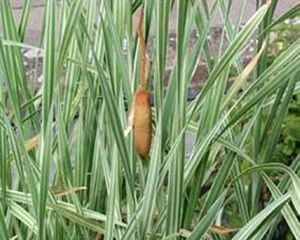 Variegated cattail, Typha latifolia 'Variegata' is an attractive bog plant for any pond. The variegation in this cattail is bold forming bright green and white longitudinal stripes. The Variegated Cattail will grow to 5 feet tall in sun to part shade. It requires moist soil or water to 12 inches deep. It does well in Zones 4-11. The Variegated Cattail doesn't grow as readily as the other cattails and doesn't like to be transplanted.
Variegated cattail, Typha latifolia 'Variegata' is an attractive bog plant for any pond. The variegation in this cattail is bold forming bright green and white longitudinal stripes. The Variegated Cattail will grow to 5 feet tall in sun to part shade. It requires moist soil or water to 12 inches deep. It does well in Zones 4-11. The Variegated Cattail doesn't grow as readily as the other cattails and doesn't like to be transplanted.
The Variegated Cattail is a nice addition to any pond and provides a taller backdrop for smaller plants around your pond. In addition, it also is a great pond plant that will attract dragonflies and other wildlife to your water garden.
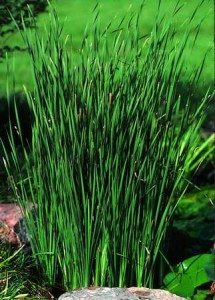 Graceful Cattails, Typha angustifolia are similar to your regular Common Cattail other than its leaves. They are more narrow leafed than the standard and the foliage arches and sways gracefully in the breeze. An elegant bog pond plant and is suitable for any pond or large container water garden. They will grow 4-6 feet tall and their catkins are very thin. The foliage makes an attractive cutting for any floral arrangement.
Graceful Cattails, Typha angustifolia are similar to your regular Common Cattail other than its leaves. They are more narrow leafed than the standard and the foliage arches and sways gracefully in the breeze. An elegant bog pond plant and is suitable for any pond or large container water garden. They will grow 4-6 feet tall and their catkins are very thin. The foliage makes an attractive cutting for any floral arrangement.
Graceful Cattails grow in sun to part shade in moist soil to water 12 inches deep and do well in Zones 3-11. They don't mind having water above their crown even during winter months and tolerate freezing temperatures well. Again Graceful Cattails are the same as other cattails and will propagate quickly from division of the rhizomes or easily grown by seed.
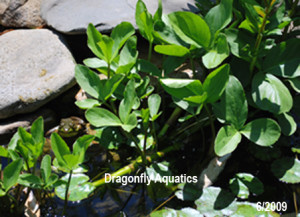 I planted this bog bean last summer and it really has taken hold in the bog. It provides a nice dense area for the frogs to hid in. (See if you can find him) It does best in 1-3 inches of water but will grow out from the margin and float over the pond. I didn't plant mine. I just anchored it underwater with the rocks around the edge of the bog and it grew from there. I already had flowers but didn't get the picture....busy time of the year. They were pink clusters that opened up to white, star-shaped blooms. They were about 5 inches taller that the leaves. They are suppose to be 2-6 inches above the leaves which gives the plant an overall height of 6-9 inches.
I planted this bog bean last summer and it really has taken hold in the bog. It provides a nice dense area for the frogs to hid in. (See if you can find him) It does best in 1-3 inches of water but will grow out from the margin and float over the pond. I didn't plant mine. I just anchored it underwater with the rocks around the edge of the bog and it grew from there. I already had flowers but didn't get the picture....busy time of the year. They were pink clusters that opened up to white, star-shaped blooms. They were about 5 inches taller that the leaves. They are suppose to be 2-6 inches above the leaves which gives the plant an overall height of 6-9 inches.
Bog bean has a highly fragrant scent and will bloom late May through July but the flowers don't last long. It needs full sun to partial shade and is hardy is Zones 2-7. It can freeze solid in the winter as long as you leave it in the water and will come back early the next spring. You can divide it after it has flowered by cutting off the rootstock.
Its a nice plant for your shallow water along the edge of the pond.
You can purchase bog bean, buck bean, Menyanthes trifoliata here.
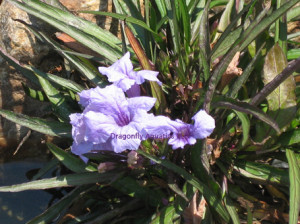 Water bluebells are one of the easiest water plants to grow. They are constantly covered with small, trumpet shaped 2 inch lavender-blue flowers with dark purple-green foliage throughout the growing season. They take sun to part shade and moist soil or water over the crown up to 6 inches deep. They reach 2 - 4 feet and about 24 inches wide. The foliage will turn a burgundy color in the autumn when the temperatures turn cooler.
Water bluebells are one of the easiest water plants to grow. They are constantly covered with small, trumpet shaped 2 inch lavender-blue flowers with dark purple-green foliage throughout the growing season. They take sun to part shade and moist soil or water over the crown up to 6 inches deep. They reach 2 - 4 feet and about 24 inches wide. The foliage will turn a burgundy color in the autumn when the temperatures turn cooler.
I normally will plant my bluebells at the pond's edge near the bog butterfly or water hibiscus to create a bushy colorful area. This is another water plant that will attract butterflies and hummingbirds in your garden.
Buy bluebells, Ruellia brittoniana here.
 This plant is an excellent water plant for stream beds, bogs or edges of your pond. It grows to about 6"-12" high out of the water and is a fast grower. It leaves are usually shiny and can be anywheres from 3 inches to only 1/2 inch in diameter. This plant is useful in the water garden because of its quick ability to create shade over the pond and grows running stems that will float out over the water surface. It creates a soft edge between water and taller plants such as the cattails, iris or sweet flags.
This plant is an excellent water plant for stream beds, bogs or edges of your pond. It grows to about 6"-12" high out of the water and is a fast grower. It leaves are usually shiny and can be anywheres from 3 inches to only 1/2 inch in diameter. This plant is useful in the water garden because of its quick ability to create shade over the pond and grows running stems that will float out over the water surface. It creates a soft edge between water and taller plants such as the cattails, iris or sweet flags.
It will grow well in sun to part shade and is hardy in Zones 5-11. It grows best in moist soil to water no more than 4 inches deep.